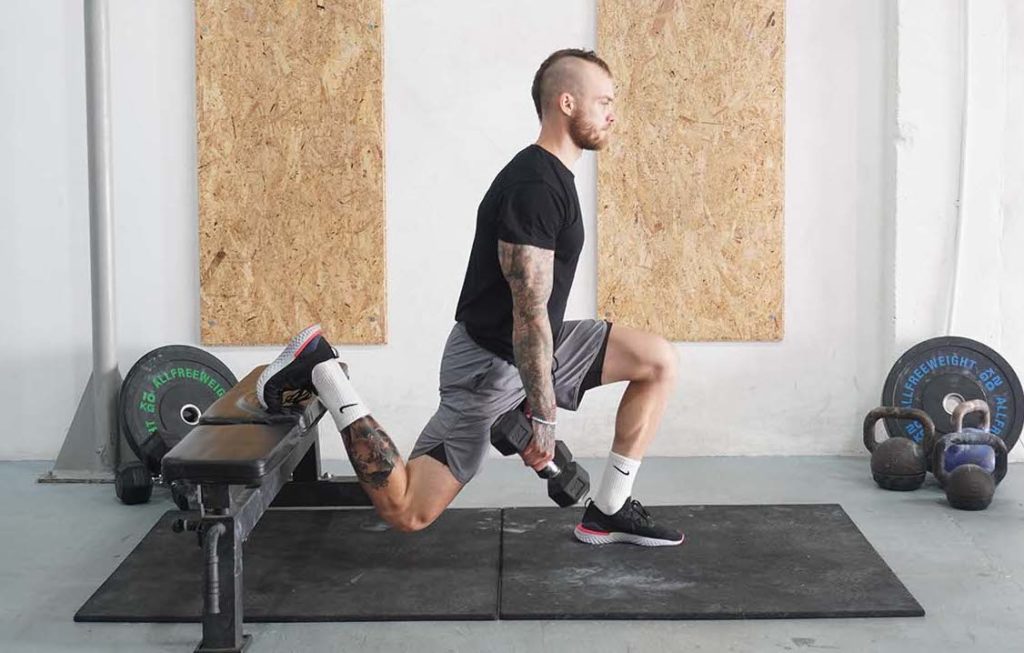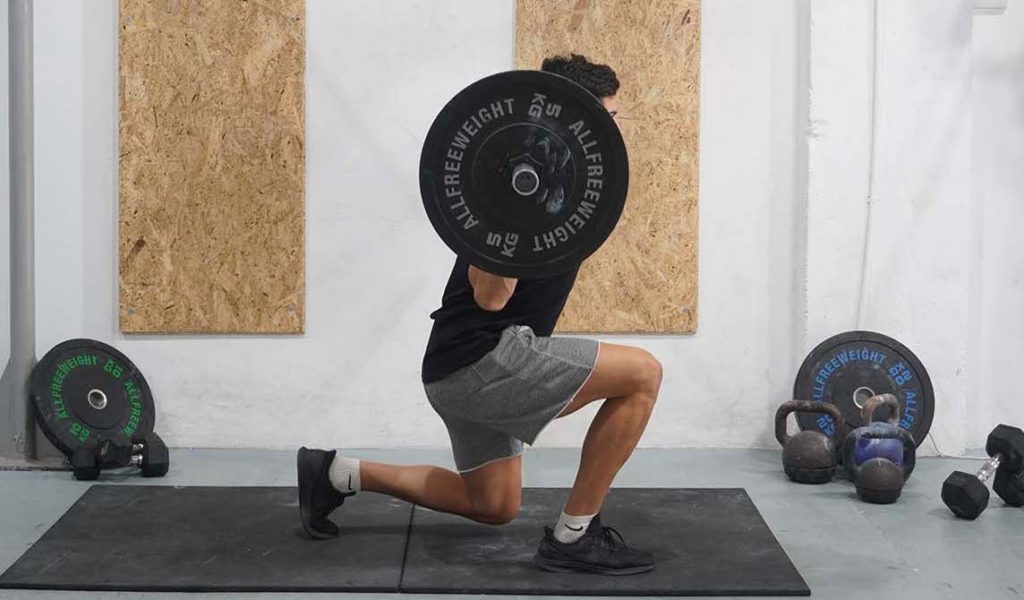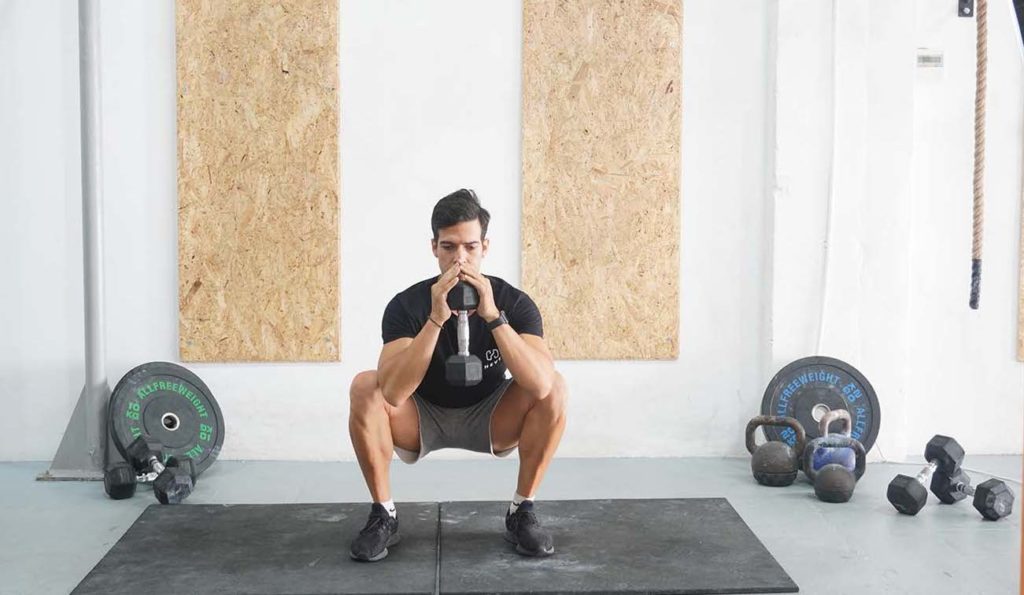The Benefits of the Split Squat
The dumbbell split squat is an effective exercise that works one side at a time, leading to balanced development, more stability, and a good mind-muscle connection. To perform the split squat, you must extend one leg forward and sink into a lunge. Descend until your posterior knee gets close to the floor and engage your quadriceps to extend your front knee.
Aside from the above benefits, the split squat is beneficial because it overloads your leg muscles with less weight and develops strength. Your sports performance improves, and your leg strength makes everyday activities like walking and climbing stairs more accessible.
We recommend including the dumbbell split squat early in your training while you’re still new to the exercise. Start with the bodyweight version and introduce dumbbells after two or more weeks. You can then move the split squat near the middle or end of your leg training once you become more proficient with the movement.
Level of Exercise: Beginner
How to do a Dumbbell Split Squat
- Grab a pair of dumbbells and get into the starting position with your feet in a comfortable stance, toes pointing slightly out, and arms extended and by your sides.
- Extend your right leg forward through a lunge and plant the foot. The ideal stance will vary from person to person, but you don’t want to extend too far forward or plant the foot too close to your body.
- Take a breath and descend by bending your front knee and transferring weight onto the front foot while keeping the heel in contact with the floor. Leaning forward slightly isn’t fatal, but your torso should remain upright.
- Move down until your back knee is a couple of inches from the floor, and pause at the bottom for a second. Your rear foot should serve to anchor you in position.
- Engage your quadriceps and squeeze your glutes to extend your front knee, bringing yourself to the top. Exhale as you move up.
- Take another breath and repeat.
- Once finished training the right leg, bring it back, lunge forward with your left one, and perform the same number of repetitions, using the same form.
What muscles does a dumbbell split squat activate?
The primary muscle group involved in the dumbbell split squat is the quadriceps, which make up the front of our thighs and produce knee extension (straightening of the knee) (1, 2). Our quadriceps engage as we begin to descend into a squat and become increasingly active as we move up.
Our glutes and hamstrings also contribute during split squats, but their role is mainly limited to stability. Our glutes become more involved in the split squat if we extend the front leg enough to stretch the buttocks area (2). In contrast, our hamstrings mainly contribute to keeping the knee and hip stable.
The midsection musculature also plays a role during the dumbbell split squat. Our rectus and transverse abdominis, obliques, and back muscles flex isometrically to provide torso support during the movement. Similarly, our arms, shoulders, and upper back play a minor role, allowing us to support weights in our hands during the exercise.
Tips on Proper Form when Performing a Dumbbell Split Squat
An important tip for an effective split squat is to find the proper stance. Your front foot shouldn’t be too close to your rear foot, but it also shouldn’t be too far forward. The ideal stance is when your front shin remains relatively vertical, and the front knee doesn’t move past your toes. Too much forward lean would place excessive stress on the front knee.
Another tip for a safe split squat is to push through the front foot heel once you’re ready to move back to the top. Doing so is beneficial for engaging your quadriceps and maintaining your balance during the split squat.
Breathing well is also crucial during the split squat. Consistent breathing provides the oxygen your muscles need and supports torso rigidity for a safer and more effective split squat. You should take a breath before descending and exhale as you push yourself back to the top position on each rep.
The fourth tip is to start with the bodyweight split squat and practice the proper technique for at least a couple of weeks before introducing dumbbells or a barbell. Split squats are highly technical and require good form, a solid starting position, and body control to benefit trainees.
Variations and Modifications of the Dumbbell Split Squat
1. Bulgarian Split Squat

The Bulgarian split squat is a variation where you elevate your rear foot on a sturdy object, such as a flat gym bench, plyometric box, or chair. Doing so makes the exercise more challenging, stretches the rear leg better, and increases the range of motion. It’s best to master the regular split squat before attempting the rear-leg elevated version.
2. Barbell Split Squat

A barbell split squat is a variation where you place a loaded barbell over your back instead of holding dumbbells. The variation is helpful for people who want to train with a heavier weight or prefer using a barbell.
3. Pause Split Squat
The pause split squat is a simple variation that prevents you from taking advantage of the stretch reflex at the bottom position. As such, your front quadriceps has to work extra hard to produce the necessary force for you to extend your front knee after descending. Move down, hold the bottom position for at least two seconds, and push yourself to the top position.
Mistakes to Avoid
Not Squatting Deep Enough
A relatively common error with the dumbbell split squat is shortening the range of motion, often because trainees use too much weight. Not squatting deep enough is bad because it prevents you from loading the front leg as effectively, making the movement less effective. Avoid the error by using lighter dumbbells or doing the bodyweight split squat if you must. Lower yourself until your back knee is almost to the floor, pause for a moment, and move back up.
Improper Stance
The second error with the split squat is improper foot stance. Trainees often bring the front leg too far forward or keep it too close to the body, neither of which is beneficial. Lunging too far makes it more challenging to maintain your balance and prevents you from loading the quadricep as effectively. In contrast, keeping your front leg too close to your body shortens the range of motion, makes the movement more awkward, and forces the knee to travel in front of the toes, putting stress on the joint. The ideal foot stance lets you keep your front shin relatively vertical and the heel planted on the floor.
Similar Exercises to the Dumbbell Split Squat
Goblet Squat

Goblet squats are a practical accessory exercise for the quadriceps. The objective is to hold a dumbbell or kettlebell in front of your chest as you perform the exercise. Doing so forces you to maintain a more upright torso which is beneficial for emphasizing the quadriceps and strengthening your upper back (3).
Lunge (Dumbbell)
Dumbbell lunges are similar to the split squat in many ways. Both exercises feature an identical movement pattern and range of motion, making them ideal for training and developing the same muscle group (4). The primary difference is that you assume a stance and maintain it until you’ve trained one side during a split squat. In contrast, the typical way to perform lunges is by alternating. You lunge forward, perform a repetition, move back to the starting position, and lunge with the opposite leg.
Dumbbell Step Up
Similar to the dumbbell split squat, step ups are a fantastic exercise for training one side at a time. The objective is to stand in front of a sturdy elevated object, such as a flat gym bench or plyo box, raise one leg, plant the foot, and engage the quadriceps to move up. Once at the top, lower yourself, extend the opposite leg and perform another repetition.

